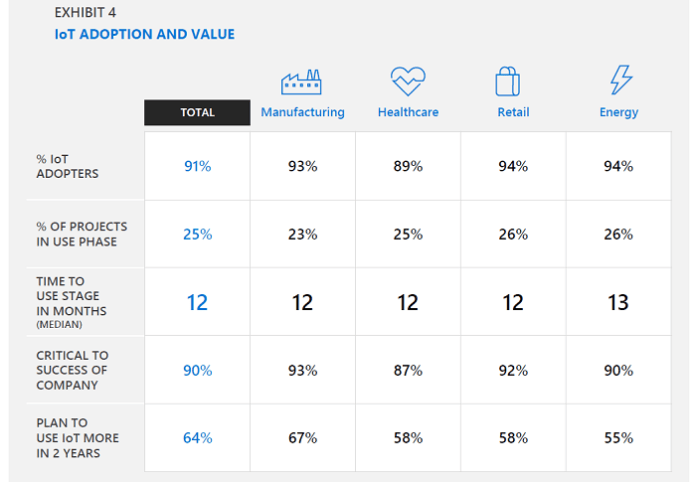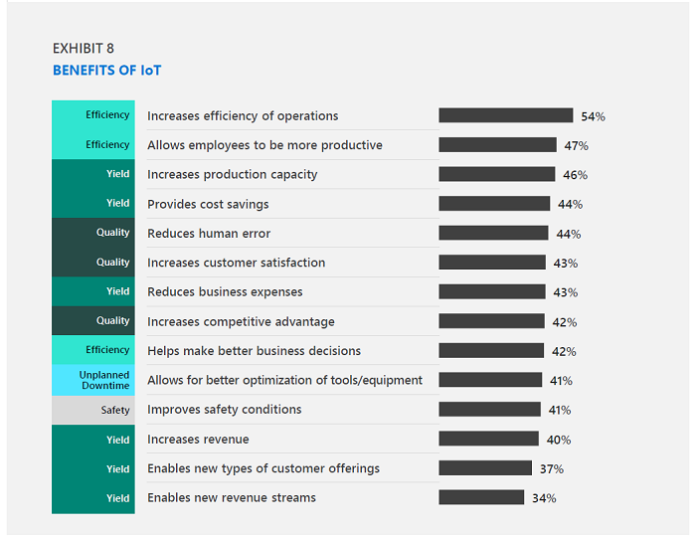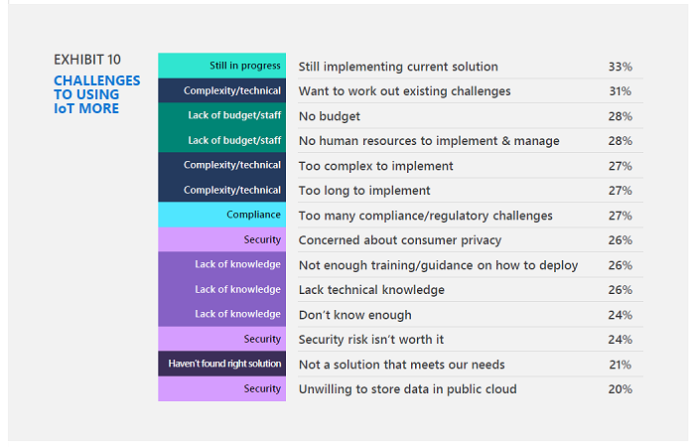Microsoft’s IoT Signals edition 2 survey of more than 3,000 business and technical decision makers and developers involved in IoT decisions reveals that 90 percent of respondents believe IoT is critical to their company’s success. In addition, 64 percent of these decision makers across a range of industries in the U.S., U.K, Germany, France, China, and Japan plan to implement more IoT projects in the future.
Survey results clearly indicate that IoT adoption continues to grow. Among the IoT decision makers, 91 percent have adopted IoT in 2020, up from 85% in 2019, with over eight in 10 companies with at least one project in the use phase, up from seven in 10 in the previous year.
The survey revealed two out of three organizations are planning to use IoT more than they do today in the next two years. IoT uses cases range from connecting and securing factories to enabling remote patient monitoring to optimizing supply chains.
The survey also found that a high percentage of the decision-makers in the retail, healthcare, energy, and manufacturing industries are IoT adopters, and all industries had about a quarter of projects in the use stage. The majority of respondents considered IoT to be critical to their company’s success, and an even larger percentage (ranging from 92-98%) were satisfied with their company’s use of the technology (See exhibit 4).

(Source: Microsoft IoT Signals)
What are the biggest reasons to adopt IoT? According to 47 percent of respondents, one of the top reasons for adoption is safety and security. Another 47 percent said it’s to optimize operations, followed by quality assurance (45%). Other reasons cited include energy optimization (32%) and sustainability (31%).
The top benefit of IoT is increasing productivity, specifically yield (86%) and efficiency (79%), according to respondents. The survey found that 54% of companies said IoT has helped them increase operational efficiency, while 47% cited IoT as a reason for enhanced employee productivity.
Other findings show that IoT is instrumental to increasing yield: 46% said it increases production capacity, 44% said it provides cost savings, while 43% saw a reduction in business expenses. Other top benefits reported include quality (77%) and safety (41%) (See exhibit 8).

(Source: Microsoft IoT Signals)
Similar to 2019 findings, the top challenges continue to be complexity, technical issues, and internal resourcing. Twenty-seven percent of respondents reported that IoT solutions are too technically complex to implement. The same percentage said these solutions take too long to implement. Limited resources are another barrier: 28% of companies don’t have the budget, and another 28% don’t have the human resources to implement and manage IoT projects. (See exhibit 10).

(Source: Microsoft IoT Signals)
Sam George, corporate vice president, Azure IoT, shared his five things to know about IoT in 2020.
- COVID-19 is accelerating IoT adoption.
The study revealed that 91 percent of organizations have now adopted IoT (up from 85% last year). One in three decision makers say their organizations will increase their investment in IoT due to COVID-19, while another 41 percent say they’ll maintain the same level of commitment.
- Security is integral.
Ninety-seven percent of IoT decision makers have security concerns when connecting new assets, and data privacy is a top security concern for about half of all organizations. Other critical concerns include ensuring network-level security (43%) and securing endpoints (40%), while security management and managing default passwords are a lower priority.
- AI, edge computing, and digital twins technologies are becoming mainstream.
Companies that incorporate emerging technologies into their IoT solution realize more success with IoT overall, since once the value is proven it’s easier to build buy-in across the organization, he said.
AI is the most widely adopted emerging technology with 79 percent of organizations adopting AI as part of their IoT solution, and those who do perceive IoT to be more critical to their company’s success (95% versus 82%) are more satisfied with IoT (96% versus 87%).
- IoT projects are evaluated by return on investment.
The key benchmarks for evaluating the success of IoT projects is the reduction of operating costs and production efficiency even more than the number of IoT projects or direct impact on revenue, according to George. The organizations are also adopting IoT as part of a broader culture change to lead new investments for safety and security, rising three spots from 2019 to the number one reason for IoT adoption in 2020.
Productivity is a top benefit of IoT (79%), specifically operations productivity (54%) and employee productivity (47%). In addition, the top uses of IoT include operations optimization (47%) and employee productivity (43%).
- Internal resourcing and complexity continue to be top challenges.
Budget constraints can hold back the pace to progress from testing, through proof of concept, and into full use stage, while scaling an IoT solution presents a formidable shift for organizations which can create internal systems and technical obstacles. For companies who adopt IoT as part of a broader culture change and prioritize investing in the right staff they are well positioned to overcome barriers sooner.
For a deeper dive, click here to download the report.
Advertisement
Learn more about Microsoft








